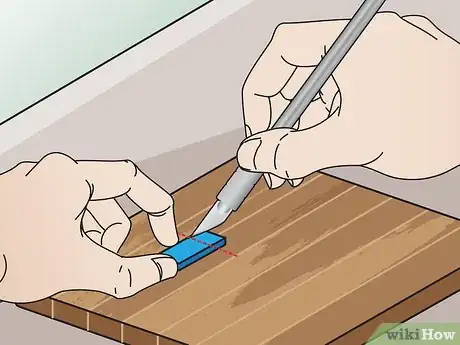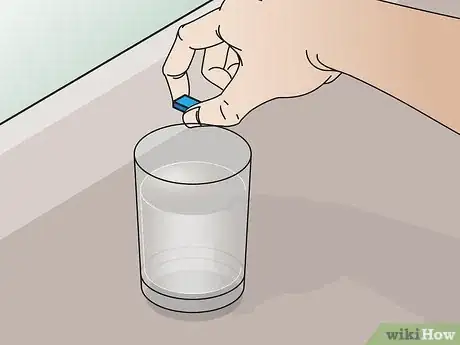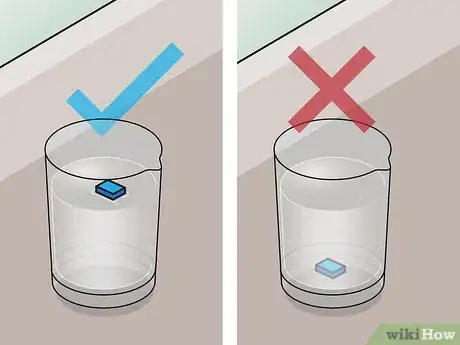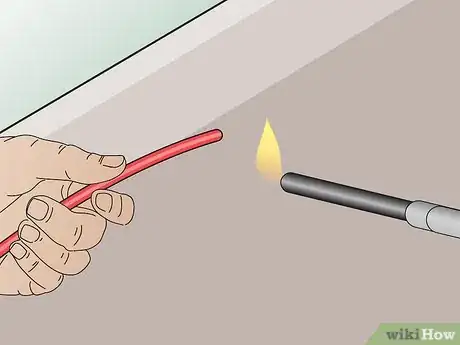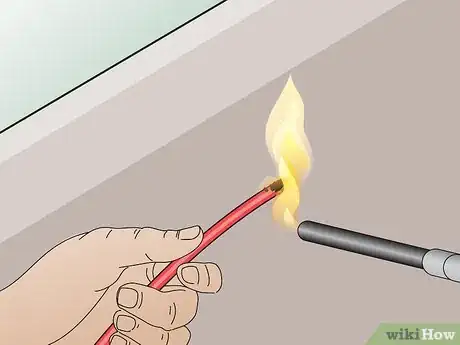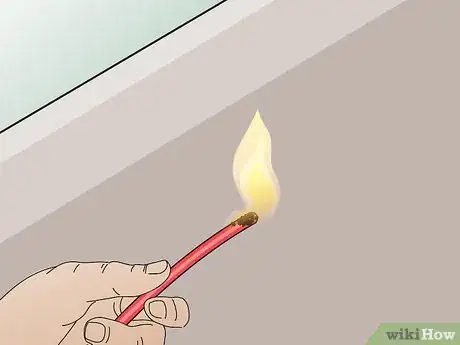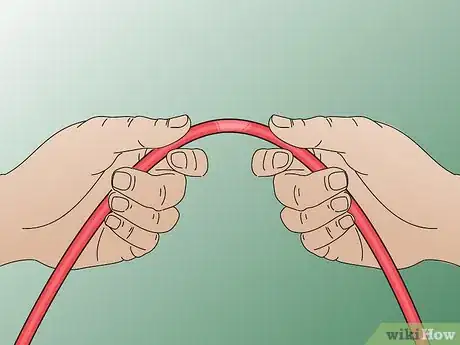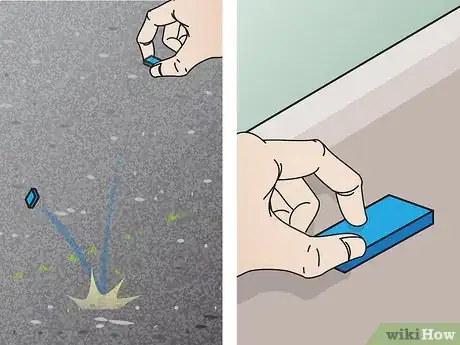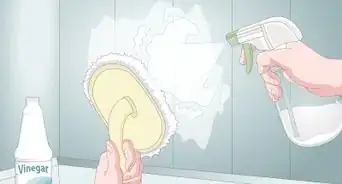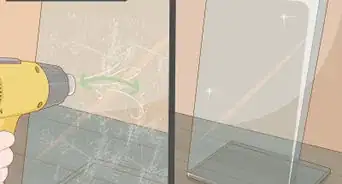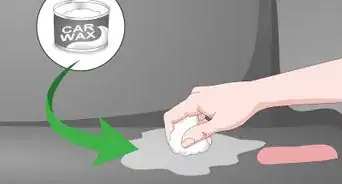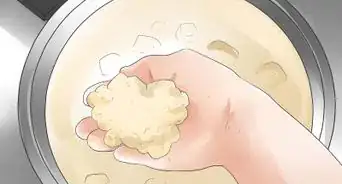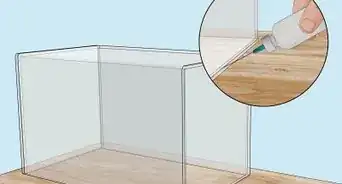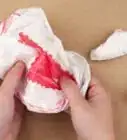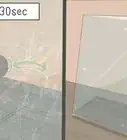This article was co-authored by wikiHow Staff. Our trained team of editors and researchers validate articles for accuracy and comprehensiveness. wikiHow's Content Management Team carefully monitors the work from our editorial staff to ensure that each article is backed by trusted research and meets our high quality standards.
This article has been viewed 44,670 times.
Learn more...
ABS, or Acrylonitrile Butadiene Styrene, plastic is used to create things such as LEGO toys or the keys on your computer keyboard. If you're having trouble figuring out whether you have ABS plastic or not, there are a couple tests you can do to find out. Try checking the plastic's density by placing a small section in water, and see if the plastic sinks or not. You can also conduct a burn test, checking for signs such as a yellow flame with blue edges or a sharp smell to indicate that it's ABS plastic.
Steps
Checking the Density
-
1Cut off a small section of the plastic. Use sharp scissors or a razor blade to cut a small square out of the plastic — a 1 inch (2.5 cm) square will work, but you can also use a slightly larger piece if desired.[1]
- If you’re using a razor blade, put down a cutting board or other thick surface so that the razor blade doesn’t damage your table.
- If you aren't able to cut up the plastic, you can use a different method that won't cause damage.
-
2Place the piece of plastic in a glass of water. Fill a cup or small container with cool or room temperature water. Drop the cut piece of plastic into the water.[2]
- You don’t need to fill the container all the way up with water — the plastic just needs enough room to either float or sink to the bottom.
Advertisement -
3Watch to see if the plastic sinks or floats in the water. If the plastic floats, it isn’t ABS plastic. If the piece of plastic sinks, it’s possible that it’s ABS plastic.[3]
-
4Conduct another test using glycerin to be more certain it’s ABS, if desired. While ABS plastic sinks in water, so do several other plastics. If you’d like to be more sure, you can fill a cup with glycerin. If the plastic floats in the glycerin, it’s likely ABS.[4]
- It floats because glycerin is denser than ABS plastic.
Conducting a Burn Test
-
1Place the plastic against a flame. Start a small flame, using something like a lighter or a small candle. Hold the plastic so that it’s touching the flame, being careful not to burn yourself.[5]
- A long neck lighter would be the best and safest option since the flame won’t be near your fingers.
- You don't need to cut the plastic into smaller sections when holding it in the flame.
-
2Observe the color of the flame when the plastic is in the fire. ABS plastic will produce a yellow flame while other plastics may produce a green, blue, or orange flame. Look for blue edges around the yellow flame, indicating it’s ABS plastic.[6]
-
3Notice a pungent smell if the plastic is ABS. ABS plastic has a very strong, acrid smell when it burns. If the plastic is giving off a stinging smell that’s irritating to your nose, it could be ABS.[7]
- Don’t inhale too much of the fumes when smelling the plastic, as some plastics can be toxic when melted.
- ABS plastic has also been said to smell rubbery.
-
4Look for black smoke coming from the flame. When you’re holding the plastic in the flame, you should see black smoke if it’s ABS. The air will also have a sooty quality.[8]
-
5Remove the plastic from the flame to see if it continues burning. ABS plastic is one that continues to burn even after the flame is taken away or shut off. Look for drips produced from the fire as well, indicating it’s ABS plastic.[9]
Doing a Non-Damaging Test
-
1Look for a label. Many plastics now have labels on them telling which type of plastic they are for recycling purposes. Look for the letters "ABS" on the piece of plastic — they may be in very small print.[10]
- Sometimes ABS will be labeled as "Other."
- If you see abbreviations such as PETE, PVC, HDPE, or PP, these are other types of plastics, meaning it isn't ABS.
-
2Try bending the plastic. You won't be able to do this if your plastic is super thick, but try bending the plastic in half with your hands if it's thinner. ABS plastic tends to bend instead of break in half like other plastics.[11]
- If it bends, you may see a white line form in the crease.
-
3Drop the plastic or scratch it to see if it's effected. ABS plastic is incredibly tough and durable. If you drop the plastic and it immediately gets scuff marks all over it, it's not ABS. You can also try scratching the plastic with your fingernails — ABS plastic won't get scratched easily.
- ABS plastic is also known for its shock absorbency.
-
4Wipe acetone on a small section of the plastic. Dip a cotton swab in acetone and lightly rub it on a tiny part of the plastic, just for a few seconds. If it's ABS plastic, you'll see the spot that you rubbed become smooth and obviously effected by the acetone.
- If you leave ABS plastic in acetone, it will eventually disintegrate, almost as if it's melting.
Warnings
- The burn test is considered more dangerous, so only conduct this test if necessary.⧼thumbs_response⧽
- Don't conduct the burn test near flammable objects.⧼thumbs_response⧽
References
- ↑ https://makezine.com/2011/09/22/identifying-unknown-plastics/
- ↑ https://makezine.com/2011/09/22/identifying-unknown-plastics/
- ↑ https://makezine.com/2011/09/22/identifying-unknown-plastics/
- ↑ https://makezine.com/2011/09/22/identifying-unknown-plastics/
- ↑ http://www.modernplastics.com/wp-content/uploads/2015/03/how-to-identify-plastics.pdf
- ↑ http://www.modernplastics.com/wp-content/uploads/2015/03/how-to-identify-plastics.pdf
- ↑ http://www.modernplastics.com/wp-content/uploads/2015/03/how-to-identify-plastics.pdf
- ↑ http://www.modernplastics.com/wp-content/uploads/2015/03/how-to-identify-plastics.pdf
- ↑ http://www.modernplastics.com/wp-content/uploads/2015/03/how-to-identify-plastics.pdf
